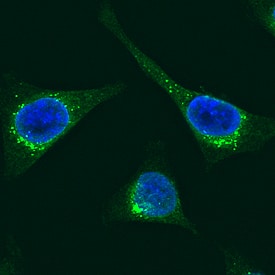Human Protein Disulfide Isomerase/P4HB Alexa Fluor® 488-conjugated Antibody
R&D Systems, part of Bio-Techne | Catalog # IC4236G


Key Product Details
Species Reactivity
Applications
Label
Antibody Source
Product Specifications
Immunogen
Asp18-Lys505
Accession # P07237
Specificity
Clonality
Host
Isotype
Scientific Data Images
Protein Disulfide Isomerase/P4HB in HeLa Human Cell Line.
Protein Disulfide Isomerase/P4HB was detected in formaldehyde fixed HeLa human cervical epithelial carcinoma cell line using Mouse Anti-Human Protein Disulfide Isomerase/P4HB Alexa Fluor® 488‑conjugated Monoclonal Antibody (Catalog # IC4236G) at 1:10 dilution for 3 hours at room temperature and counterstained with DAPI (blue). Specific staining was localized to the endoplasmic reticulum. View our protocol for Fluorescent ICC Staining of Cells on Coverslips.Applications
Immunocytochemistry
Sample: Formaldehyde fixed HeLa human cervical epithelial carcinoma cell line
Formulation, Preparation, and Storage
Purification
Formulation
Shipping
Stability & Storage
- 12 months from date of receipt, 2 to 8 °C as supplied.
Background: Protein Disulfide Isomerase/P4HB
P4HB (Prolyl 4-hydroxylase beta chain; also PDI) is a 60 kDa member of the protein disulfide isomerase family. As an intracellular homodimer, it forms a tetrameric complex with P4H alpha chains to form an active prolyl 4-hydrolyase. This catalyses the hydroxylation of proline in collagen. On the cell surface, it reduces disulfide bonds in HIV that allow the virus to fuse with CXCR4 and enter susceptible cells. Mature human P4HB is 491 amino acids (aa) in length. It contains two TRX domains (aa 25-134 and 368-475) plus an ER retention sequence (aa 505-508). There is one potential isoform that shows an 11 aa substitution for the first 162 amino acids. Over aa 18-505, human P4HB shares 94% aa identity with mouse P4HB.
Long Name
Alternate Names
Gene Symbol
UniProt
Additional Protein Disulfide Isomerase/P4HB Products
Product Specific Notices
This product is provided under an agreement between Life Technologies Corporation and R&D Systems, Inc, and the manufacture, use, sale or import of this product is subject to one or more US patents and corresponding non-US equivalents, owned by Life Technologies Corporation and its affiliates. The purchase of this product conveys to the buyer the non-transferable right to use the purchased amount of the product and components of the product only in research conducted by the buyer (whether the buyer is an academic or for-profit entity). The sale of this product is expressly conditioned on the buyer not using the product or its components (1) in manufacturing; (2) to provide a service, information, or data to an unaffiliated third party for payment; (3) for therapeutic, diagnostic or prophylactic purposes; (4) to resell, sell, or otherwise transfer this product or its components to any third party, or for any other commercial purpose. Life Technologies Corporation will not assert a claim against the buyer of the infringement of the above patents based on the manufacture, use or sale of a commercial product developed in research by the buyer in which this product or its components was employed, provided that neither this product nor any of its components was used in the manufacture of such product. For information on purchasing a license to this product for purposes other than research, contact Life Technologies Corporation, Cell Analysis Business Unit, Business Development, 29851 Willow Creek Road, Eugene, OR 97402, Tel: (541) 465-8300. Fax: (541) 335-0354.
For research use only